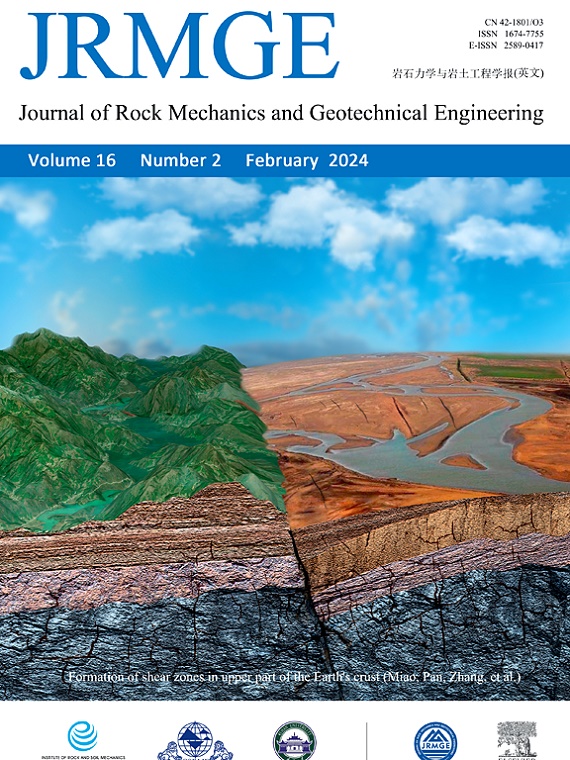不同加载循环和应力路径下双江口花岗岩力学参数演化
IF 10.2
1区 工程技术
Q1 ENGINEERING, GEOLOGICAL
Journal of Rock Mechanics and Geotechnical Engineering
Pub Date : 2023-10-01
DOI:10.1016/j.jrmge.2023.09.005
引用次数: 0
摘要
在深部硬岩开挖过程中,不同位置的围岩通常受到不同的应力路径。为揭示不同应力路径下深部围岩的力学参数,提出了一种可控真三轴加卸载和主应力方向互换的循环加卸载试验新方法,研究了双江口花岗岩在不同应力路径下的变形模量、弹性变形增量比、断裂程度、内聚力和内摩擦角。此外,定义了新的应力路径系数来表征不同的应力路径,得到了应力路径系数与岩石破碎度差系数、黏聚力和内摩擦角之间的函数关系。结果表明:在真三轴循环加卸载过程中,随着等效裂纹应变的增大,变形模量和黏聚力逐渐减小,内摩擦角逐渐增大;应力路径系数与岩石破裂度差系数呈指数关系。随着应力路径系数的增大,黏聚力减弱程度和内摩擦角增强程度呈线性减小。真三轴主应力方向互换循环加卸载过程中,裂纹发育方向发生变化,变形模量增大,而黏聚强度和内摩擦角略有减小,说明主应力方向互换对围岩具有强化作用。最后,讨论了主应力交换方向对深基坑工程稳定性的影响。本文章由计算机程序翻译,如有差异,请以英文原文为准。
Evolution of mechanical parameters of Shuangjiangkou granite under different loading cycles and stress paths
Surrounding rocks at different locations are generally subjected to different stress paths during the process of deep hard rock excavation. In this study, to reveal the mechanical parameters of deep surrounding rock under different stress paths, a new cyclic loading and unloading test method for controlled true triaxial loading and unloading and principal stress direction interchange were proposed, and the evolution of mechanical parameters of Shuangjiangkou granite under different stress paths were studied, including the deformation modulus, elastic deformation increment ratios, fracture degree, cohesion and internal friction angle. Additionally, the new stress path coefficient was defined to characterize different stress paths, and the functional relationships among the stress path coefficient, rock fracture degree difference coefficient, cohesion and internal friction angle were obtained. The results show that during the true triaxial cyclic loading and unloading process, the deformation modulus and cohesion gradually decreases, while the internal friction angle gradually increases with increasing equivalent crack strain. The stress path coefficient is exponentially related to the rock fracture degree difference coefficient. As the stress path coefficient increases, the degrees of cohesion weakening and internal friction angle strengthening decreased linearly. During cyclic loading and unloading under true triaxial principal stress direction interchange, the direction of crack development changes, and the deformation modulus increased, while the cohesion strengths and internal friction angle decreases slightly, indicating that the principal stress direction interchange has a strengthening effect on surrounding rocks. Finally, the influences of the principal stress interchange direction on the stabilities of deep engineering excavation projects are discussed.
求助全文
通过发布文献求助,成功后即可免费获取论文全文。
去求助
来源期刊

Journal of Rock Mechanics and Geotechnical Engineering
Earth and Planetary Sciences-Geotechnical Engineering and Engineering Geology
CiteScore
11.60
自引率
6.80%
发文量
227
审稿时长
48 days
期刊介绍:
The Journal of Rock Mechanics and Geotechnical Engineering (JRMGE), overseen by the Institute of Rock and Soil Mechanics, Chinese Academy of Sciences, is dedicated to the latest advancements in rock mechanics and geotechnical engineering. It serves as a platform for global scholars to stay updated on developments in various related fields including soil mechanics, foundation engineering, civil engineering, mining engineering, hydraulic engineering, petroleum engineering, and engineering geology. With a focus on fostering international academic exchange, JRMGE acts as a conduit between theoretical advancements and practical applications. Topics covered include new theories, technologies, methods, experiences, in-situ and laboratory tests, developments, case studies, and timely reviews within the realm of rock mechanics and geotechnical engineering.
 求助内容:
求助内容: 应助结果提醒方式:
应助结果提醒方式:


